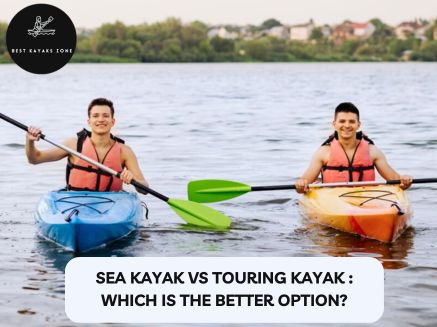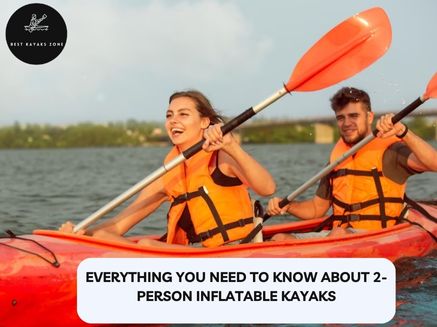
Tessa Young
Kayak Expert

John Smith
Expert Reviewed |Kayak Expert
Update
When choosing between a sea kayak vs touring kayak, understanding the key differences can help you pick the right one. Sea kayaks are designed for open waters and rougher conditions, while touring kayaks excel in longer, more relaxed trips on lakes and rivers. Your decision ultimately depends on where you plan to paddle and the features you prioritize for your adventure.

On This Page
What is a Sea Kayak?
A sea kayak is an elegantly crafted vessel, meticulously designed for the vast and unpredictable realms of open water. Unlike its recreational counterparts, a sea kayak’s elongated and slender hull is tailored for the rigors of the ocean, withstanding the fury of waves, the pull of tides, and the capricious dance of the wind.
These kayaks are typically longer, ranging from 12 to 18 feet, and their narrow beam ensures efficiency in slicing through water, allowing paddlers to maintain speed over long distances. A hallmark of sea kayaks is their capacity for self-rescue, with features like sealed bulkheads and deck rigging that ensure safety even when the waters turn turbulent. Moreover, their design doesn’t just cater to survival; it caters to the adventurer, with ample storage space for gear, food, and camping supplies, making them indispensable for multi-day voyages across the ocean’s expanse.
Pros and Cons of Sea Kayaks
Pros
Exceptional Stability in Adverse Conditions: Sea kayaks are engineered to handle the tumult of open water, providing stability even in the face of rolling waves and unpredictable swells. Their low profile minimizes the impact of wind, allowing for greater control.
Extensive Storage Capabilities: Designed with the expeditions in mind, sea kayaks boast voluminous storage compartments that can accommodate everything from camping gear to provisions, making them ideal for long-haul journeys.
Superior Construction: Often constructed from high-grade materials like fiberglass, carbon fiber, or rotomolded plastic, sea kayaks are built to withstand the harshest marine environments, offering durability that stands the test of time.
Efficient Tracking and Speed: The streamlined hull of a sea kayak ensures that it tracks well in a straight line, allowing paddlers to cover more distance with less effort—a crucial factor when paddling across open water.
Comprehensive Safety Features: Sea kayaks are equipped with essential safety features, including watertight bulkheads, deck lines, and often, a rudder or skeg for improved directional control in challenging conditions.
Cons
Hefty and Cumbersome: The robust construction and added features of sea kayaks make them heavier and more difficult to transport. Their length and weight can also make storage a challenge for those with limited space.
Higher Cost: The advanced materials and specialized design drive up the cost of sea kayaks, making them a significant investment, particularly for those new to the sport.
Steeper Learning Curve: Mastering a sea kayak, especially in rough waters, requires advanced paddling skills. Beginners may find the learning process daunting, particularly when dealing with rescues or navigating in adverse conditions.
Specialized Use: Sea kayaks excel in their intended environment—open water. However, their design is less suited for narrow, winding rivers or shallow waters, limiting their versatility.
What is a Touring Kayak?
Touring kayaks offer a more versatile approach to paddling, designed to perform well in a variety of water conditions, from serene lakes and rivers to the more challenging coastal waters. These kayaks are generally shorter and wider than sea kayaks, typically ranging from 10 to 14 feet, which grants them enhanced maneuverability without sacrificing stability. Touring kayaks strike a balance between speed and comfort, making them a preferred choice for paddlers who enjoy day trips or shorter excursions, though they can still accommodate the occasional multi-day adventure. The design of a touring kayak provides enough storage for essential gear, while its user-friendly features make it accessible to paddlers of all skill levels.
Pros and Cons of Touring Kayaks
Pros
Highly Versatile: Touring kayaks are designed to handle a wide range of environments, from placid lakes and slow-moving rivers to coastal areas with mild surf, offering paddlers the flexibility to explore diverse waterscapes.
Enhanced Maneuverability: The shorter length and broader hull of touring kayaks make them more agile, allowing for quick turns and easy navigation in confined spaces or winding waterways.
Comfort-Oriented Design: Touring kayaks often feature larger cockpits and adjustable seats, providing superior comfort for long hours on the water, which is particularly beneficial during extended trips.
Affordability: Compared to sea kayaks, touring kayaks are generally more affordable, making them an attractive option for recreational paddlers who want a balance of performance and price.
Beginner-Friendly: The design of touring kayaks is more forgiving, making them easier to control and a great option for those new to kayaking.
Cons
Moderate Speed: While touring kayaks are efficient, they don’t match the speed of sea kayaks, particularly over longer distances. Paddlers looking to cover extensive stretches of open water may find them slower.
Limited Storage: Although touring kayaks offer some storage, it’s not as generous as that of sea kayaks, which can be a drawback for those planning longer trips requiring more gear.
Less Optimal in Rough Waters: Touring kayaks, while stable, may not perform as well in rough, open water conditions as sea kayaks, which are specifically designed for such environments.
Potential Durability Concerns: Depending on the model and materials used, some touring kayaks may not be as durable as sea kayaks, particularly in the face of rough handling or adverse conditions.
Key Differences Between Sea Kayaks and Touring Kayaks
Design and Structure
Sea kayaks are characterized by their longer, narrower build, designed to handle the rigors of open water with a focus on speed and tracking. Touring kayaks, in contrast, are shorter and wider, offering a balance between stability and maneuverability that makes them suitable for a variety of water conditions.
Performance and Handling
Sea kayaks are designed for long-distance travel in a straight line, excelling in tracking and speed. Touring kayaks, however, are more maneuverable, allowing for quicker turns and easier handling in tighter spaces, making them versatile for different water environments.
Storage and Features
When it comes to storage, sea kayaks offer larger compartments to accommodate gear for multi-day trips. Touring kayaks, while offering sufficient storage for day trips, may fall short when it comes to packing for extended adventures.
Comfort and Ergonomics
Touring kayaks often prioritize paddler comfort with larger cockpits and more adjustable seating, making them more comfortable for long outings. Sea kayaks, while comfortable, emphasize a tighter fit for better control in challenging conditions.
Speed and Maneuverability
The streamlined hull of a sea kayak provides superior speed, especially over long distances. Touring kayaks, while not as fast, offer greater maneuverability, making them ideal for environments where quick direction changes are necessary.
Material and Durability
Sea kayaks are often constructed from higher-grade materials like fiberglass or Kevlar, ensuring they can withstand harsh marine environments. Touring kayaks, while still durable, may use lighter, more flexible materials, making them easier to transport but potentially less resilient.
Choosing the Right Kayak for Your Needs
When to Choose a Sea Kayak
A sea kayak is the ideal choice if your adventures take you into the open ocean or large, turbulent lakes where stability, speed, and ample storage are essential. It’s the go-to vessel for multi-day expeditions and for paddlers who prioritize performance in challenging conditions.
When to Choose a Touring Kayak
A touring kayak is perfect for those who paddle in a variety of conditions, including rivers, lakes, and coastal areas. It’s a versatile, user-friendly option that balances performance and comfort, making it an excellent choice for day trips and occasional multi-day outings.
Final Thoughts
Choosing between a sea kayak and a touring kayak ultimately comes down to your specific needs and the environments you plan to explore. Sea kayaks offer unmatched performance in the demanding conditions of open water, while touring kayaks provide versatility and comfort across a range of water types. Understanding these key differences will help you make an informed decision, ensuring your kayak is not just a vessel, but a trusted companion on your waterborne adventures.
FAQS:
Which kayak handles rough water better?
Sea kayaks are designed to handle rough water and turbulent conditions better due to their longer, narrower shape and more robust build. They often have features like deeper hulls and better tracking to effectively manage waves and strong currents.
Can I use a touring kayak for long trips?
Yes, touring kayaks are specifically designed for long trips. They have ample storage space, comfortable seating, and efficient hull designs to cover long distances and handle varying conditions.
What is the main difference in design between sea and touring kayaks?
Sea kayaks are typically designed for coastal and open water conditions, focusing on stability and handling in rough seas. Touring kayaks are optimized for longer journeys with features like extra cargo space and a design suited for efficiency over distance.
How do the hull shapes differ between sea and touring kayaks?
Sea kayaks usually have a V-shaped hull for better tracking and stability in choppy water. Touring kayaks often feature a more rounded hull for smoother paddling efficiency over long distances and better overall comfort.
About Author

Tessa Young
Kayak Expert
Tessa Young is a highly experienced kayak expert with over 8 years of dedicated work in the kayaking industry. Her in-depth knowledge and passion for water sports make her a reliable source of information for kayakers of all levels. Tessa has extensively tested and reviewed a wide range of kayaks, offering expert advice to help readers make informed decisions. Her insights are valued by those looking for trustworthy recommendations on the best kayaks for various needs and environments.
Read More

John Smith
Expert Reviewed | Kayaks Expert
John Smith is an accomplished kayak reviewer with more than 12 years of expertise in evaluating kayak performance and quality. His thorough and unbiased reviews have made him a respected figure among kayaking enthusiasts. John’s extensive experience on the water enables him to provide detailed assessments, focusing on key aspects such as stability, speed, and durability. Readers can rely on John’s expert evaluations to guide them in choosing the right kayak for their adventures.
Read More



